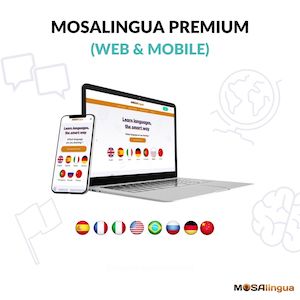Speaking fluently is the ultimate goal for most language learners. But how do you define success? What does it mean to “speak fluently,” and more importantly, how can you become fluent in a language? In this article and video, we’ll take a look at what exactly “fluency” is, and how you can improve your speaking skills to reach that goal.

Defining Fluency
Of course, if you want to know exactly what fluency means, the best place to look is the dictionary! The Cambridge dictionary defines fluency as, “The ability to speak or write a language easily, well and quickly.” Merriam-Webster defines fluency as, “The quality or state of being fluent,” and further defines fluent as: “capable of using a language easily and accurately.”
These are useful definitions, and they highlight some key aspects of fluency: (1) speaking, writing or using a language, and doing so (2) easily (meaning without effort), (3) well or accurately (meaning without making mistakes), and (4) quickly (meaning without long pauses).
Another way to understand what it means to speak fluently is to look at the root of the word fluency. Fluency comes from the Latin word fluo which means “to flow.” And if you think about it, when you speak a language easily and well, the conversations you have tend to flow as well. Not only are you able to communicate effectively, but you can understand everything the other person says and respond without hesitation. This is what it means to be fluent: mastering a language such that communication flows easily in both directions.
A definition for fluency with an achievable goal
For a more concrete and measurable definition, I think it’s fair to say that you’ve “mastered” a language when you reach a B2 level on the CEFR scale. (You might like this article if you’re starting to learn a new language from scratch.) In other words, you may not have a totally perfect vocabulary, and you may occasionally make grammatical mistakes (after all, even first-language speakers rarely have perfect vocabulary and grammar!). But at the end of the day, you’re able to use the language in a wide variety of situations, you understand most of what you hear, and you can respond fairly spontaneously. You can use whichever definition of fluency you like best, but for the remainder of the article, we’ll be focusing on this one.
How to Become Fluent in a Language
-
Build a rich vocabulary
In order to really become fluent in a language, you’ll need to have a rich vocabulary. Of course, you don’t need to know all the words that a native speaker might use. Still, you should be able to understand any and all words that are used commonly and in regular language. Additionally, you should have a larger passive vocabulary than active vocabulary.
Passive vocabulary is all the words you recognize when you read or hear them, and it’s usually larger than your active vocabulary, which is the words you use when speaking your target language. A large passive vocabulary will allow you to understand everything that’s being said to you, even if your own speech is more limited (which is OK, because you don’t really need all that many words to express yourself).
It’s also important to concentrate on the right words, and use appropriate methods to learn them. Otherwise, you could end up knowing thousands of specialized vocabulary, and still not be able to “speak fluently.” To learn vocabulary, we recommend using frequency lists. These are (unsurprisingly) lists of the most frequently used words for a language. We also suggest using the Spaced Repetition method to learn more quickly and effectively.
2. Improve your listening skills
As we’ve already said, communication can’t be fluid, and you can’t speak fluently if you only understand some of what’s said to you. One of your primary goals should thus be to improve your comprehension of your target language. After all, knowing the words of a language is only half the battle. You also have to be able to recognize them when you hear them. If you need some help learning how to set goals to achieve fluency, check out this article.
If you watch films without subtitles (which we recommend), you may sometimes miss words that you don’t know. That’s fine, it’s totally normal. The most important thing to do is to keep at it. Listen to your target language every day, or as often as possible. Videos, podcasts, TV series, movies, listening activities, and more. Train your ear regularly, and every day you’ll get closer and closer to full fluency.
3. Practice frequently and regularly
When you think about somebody who can speak fluently, you probably imagine somebody who can express themselves quickly, without any pauses or stutters. Somebody who can clearly and precisely explain what they want to say, without having to think about it. So, while expanding your vocabulary and improving your listening skills and comprehension are both important, fluency is all about speaking.
So, how do you get there? The only way is to practice, frequently and regularly. Frequently, because you should practice speaking as often as possible, and regularly, because it’s more effective to practice a little bit often than a whole bunch all at once. Taking several days off can lead you to lose the progress you’ve made. On the other hand, spending an entire day practicing is exhausting and will make it hard to stay motivated. Make it a habit and it’ll stop feeling like practice after a while!
If you’re not ready to speak to other people yet, check out this video that Abbe recorded on the self-talk or self-conversation technique, an innovative approach to learning to speak on your own. As soon as you can, though, you’ll want to focus on having conversations with other speakers. If you have a friend who speaks your target language, let them know you’d like to practice it together. Otherwise, there are plenty of great sites for finding conversation partners and/or tutors online.
Wrapping Up
To sum things up, you should concentrate on these three activities if you want to learn to speak fluently:
- Memorizing key words and phrases
- Developing strong listening skills
- Getting plenty of speaking practice
Video: Reach Fluency in Your Target Language
You can find all this handy info and more in Luca’s YouTube video about fluency. If you like, turn on the subtitles by clicking the ⚙ Settings icon at the bottom right. You can also use this menu to slow down the speed of the video.
Subscribe to our YouTube channel for more great tips!
If you’re interested in the topic of fluency, we recommend checking out these articles as well:
- How to Overcome the Obstacles That Are Holding You Back and Speak More Confidently
- How to Practice a Foreign Language Without Moving Abroad
- 5 Key Strategies To Learn A Language Effectively
- How to Choose the Right Language Resources
Related posts:
Start learning a new language today

Good news: we can help!
More good news: you can get started for free! Start your free trial now and for the next 15 days, take advantage of the most effective language learning method on the market!
Vocabulary flashcards, videos with subtitles, audiobooks, articles adapted to your level – with MosaLingua Premium (Web & Mobile), you’ll have access to all this and more. Get started right now. It’s free—and risk-free—to try!




Comments